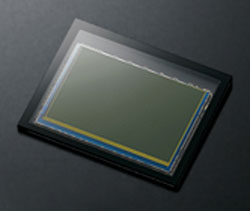Four cameras with four different sensors in 15 months. But looking at the dxomark benchmarks, there isn't much to separate them, at least until you put a lens on. At that point the D7100 stands out, and I expect the D5300 to perform similarly. I'm betting that this one is a modified Toshiba but other than cost savings, I think it is a legitimate question just what Nikon is looking for here.
I don't think so, I think it's a Sony. Here is the D5200 sensor (from Nikon's site)
The Toshiba sensors have this solid black mask. Here is the D5300 sensor
It's in a rather unusual package, which means that you can't see all the lands at the edges, one of the good ways of identifying a Sony sensor, but they do have some characteristic patterns which tend to identify Sony
I haven't found a head-on pic of the latest Sony APS-C sensors, but here's one of the A58's
Similar features to note are the unusual grey band with gold lands at the top (similar pattern), the similar blue mask stopping short of the active frame are (common on Sony sensors) and the very similar pattern at the left hand side of the active area, clipped form the D5300 below:

This kind of pattern is very characteristic of Sony sensors, going back to the A700, although this is a bit different from what we've seen before, but I think look carefully you can see a similar layout on the A58. The A58 is a 20MP sensor, and I think this is a development of that, not the old 24MP that went into the NEX7.
--
Bob



